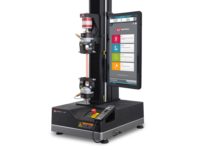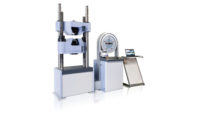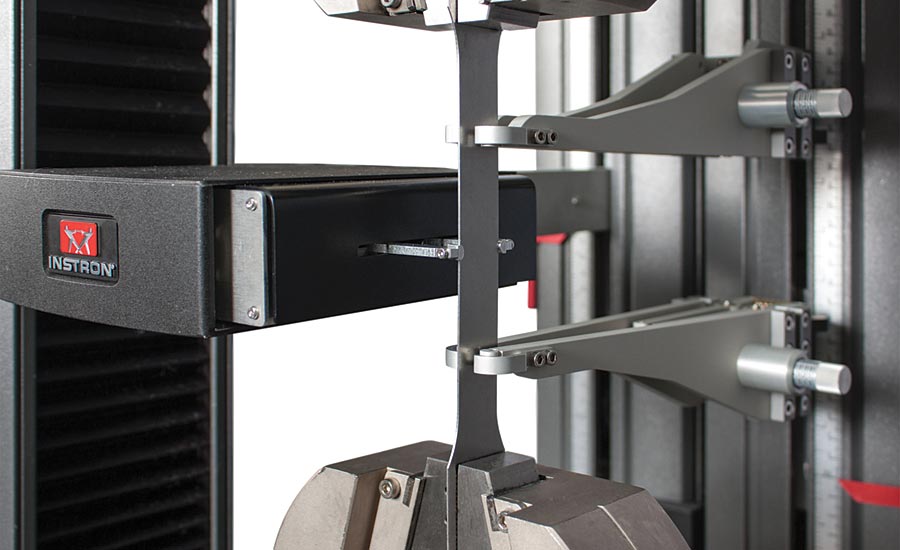Mechanical Testing of Automotive Materials and Components
Testing the performance of components is critical to many automotive suppliers in a quality control aspect—and hugely important for research and development of new products.

Figure 1: Testing sheet metallic material using an axial and transverse extensometer to determine plastic strain ratio (r-value). Source: Instron

Figure 2: Testing HDT & Vicat on a system with automated station lifting and automated weight application. Source: Instron

Figure 3: Testing composite materials with climbing drum test fixture. Source: Instron

Figure 4: Testing of full components on a universal testing machine fitted with a tapped table test plate. Source: Instron

Figure 5: Testing seatbelt materials using capstan principle gripping solution. Source: Instron

Figure 6: Testing within an environmental chamber capable of low and high temperature testing. Source: Instron






In the production of automobiles, there are many different materials that require mechanical testing. When industry changes occur, this ultimately affects the types of testing being conducted. Automotive is an extremely competitive industry where material performance will directly affect every part of a consumer’s experience with the vehicle. The key driver recently has been the need to reduce vehicle emissions to meet more stringent regulations. This can be achieved in many ways: some of the top priorities include increasing aerodynamic performance, increasing engine efficiency, and reducing the weight of the vehicle. Globally, the drive to reduce the weight of automobiles has led to a huge increase in research and development across material industries, requiring more mechanical testing of materials.
Metals Mechanical Testing
With the majority of the structure of a car still being produced in various metals, there is a huge opportunity to lightweight the vehicles by optimizing the metals used. New generation high-strength steels are being developed and produced to maintain the automotive industry’s demand for steel.
Despite this, automotive manufacturers are now working with aluminum producers more and more to increase the percentage of aluminum used in the production of automobiles. Aluminum offers low density, excellent formability, corrosion resistance and now comparable strength with ferrous materials.
The advantage of using metallic materials for the production of automobiles is that most are more or less isotropic and homogenous. This means their properties are theoretically uniform, independent of its direction. This is hugely advantageous for mechanical testing, as it means performing a uniaxial tensile test can allow for calculations of most mechanical properties. Traditionally, there has been a tradeoff between strength and formability; now, metal producers are releasing higher grades of sheet metal where the reduction in formability is minimal despite considerable strength gains. Typical calculations required include yield strength, ultimate tensile strength, elongations, and plastic strain ratio (r-value), and strain hardening exponent (n-value). R and n values are critical mechanical properties that define the formability of these products.
Plastics Mechanical Testing
Characterization of polymer properties is critical in the development and manufacturing processes of materials, as well as in quality control and in determining the functionality of a finished product. Polymers are utilized in almost all parts of a vehicle’s construction, and today, because of its increased strength, it has been advantageous to use in sections of an automobile that once were metal, including body panels. It is crucial to understand these properties as a polymer material moves through its lifecycle of raw material to compound to semi-finished to finished product.
Although several materials or parts may be developed in parallel, changes to one part, whether it is material or design related, may result in having to re-evaluate many other parts, even those being developed by other companies. In the case of plastics, the new material could have a different shrinkage factor, which could change the overall size of the part and this could lead to “fit and finish” issues with nearby components. Also, the harmonization of materials is critical to keeping the cost down, which incentivizes manufactures to limit the number of materials used. Fewer materials simplify manufacturing, providing more buying power and resulting in less suppliers. For these reasons, it is advantageous to get it right the first time, which a range of mechanical testing can help to identify.
Composite Mechanical Testing
Composite material can offer the greatest potential to reducing the mass of vehicles. Unlike metals, the materials formed are typically anisotropic, meaning that the material properties are dependent on the direction. This offers great benefits as engineers can design components by putting the strength where they need it and in the axis where it is most critical. However, very few assumptions or constants can be taken from one test, meaning there is a much larger spread of testing requirements. For instance, to determine the static bulk properties of a composite requires tension, compression and shear tests. Other tests need to be conducted to determine the inhomogeneity of the material, such as interlaminar fracture toughness, which measures the material’s resistance to delamination.
The greatest challenges of using composites for widespread use within the automotive industry is the difficulty to manufacture the material in large scale production. This is being expanded and there is great investment into making this a possibility for the future. We expect that as the production volume increases the mechanical testing requirements will increase.
Another challenge to the widespread adoption of composite materials is the end of life process, or recyclability of materials. Extensive research and development has gone into finding the most efficient way to recycle these materials once the vehicle has served its life.
Component Mechanical Testing
Testing the performance of components, whether in its physical strength or in its operation, is critical to many automotive suppliers in a quality control aspect, but is also hugely important for research and development of new products. This can be challenging as not many components being tested are similar, and therefore require specific fixturing for the individual component. Ensuring that these fixtures are centered and secured in the same place is crucial to getting repeatable results. T-slots bases are commonly used on universal testing machines to secure fixtures; however, these can be difficult to secure in exactly the same place. The recommended solution would be to use a tapped test plate—an accessory that ensures the fixtures are secured, allowing for improved repeatability.
Some components need to be tested in a way that simulates the use of the product or component. To do this you may need to create a loading profile in the testing software. Whether controlling is based on force feedback or movement, it may be important to load and unload in a specific cycle and create calculations or exports based on the results at each ramp.
Joining
The way that various materials are joined in the manufacture of an automobile is incredibly important to the overall strength, safety and quality of a vehicle. This makes the mechanical testing of materials even more critical. Joining can cover fasteners, welds and adhesives, each of which have individual testing challenges.
For automotive OEMs, switching from fasteners to weld technology can reduce the weight of components significantly. As a second effect, it can also improve the noise vibration and harshness tests that consumers typically define equally with quality. For example, switching to vibration welding of plastic components can increase the overall bond strength as well as reducing the noise in operation. Subsequently less parts are used in the assembly and the overall mass of the parts can be reduced. Mechanical testing is critical to ensure these properties during the product development cycle. Once they are introduced into production the QC environment will need to ensure all components will be of the highest quality.
Textile Testing
Textile materials application can vary, but when users enters a vehicle, they are surrounded by textiles: carpet and upholstery that has a great impact on the feel of quality and product life, and vital safety features, such as airbags and seatbelts. Each of these textiles are tested for different reasons and exhibit unique testing challenges.
The most critical safety feature for a passenger is a seatbelt. Seatbelts are tested to ensure that a passenger is kept safe at substantial G forces in the case of an accident and must be suitably strong and elongate enough to slow a person down without causing additional injury. Webbing matrices of seatbelts are extremely challenging to test with traditional gripping solutions and instead rely on grips utilizing the capstan principle to ensure accurate and repeatable results.
Another critical safety feature for vehicles is in the use of airbags. Previously there may have been two airbags in vehicles; today, there can be many more, which means more testing is required. It is crucial to determine the material’s strength, as well as the strength of the join to ensure that it can take the forces in such an impact.
Other textiles in vehicles are tested to ensure durability throughout the product lifecycle. Fabrics used in upholstery and carpeting need puncture and tear testing. Puncture tests can be performed with probes of varying geometries to ensure a material’s puncture resistance to different objects. Seam strength and tear testing help to verify that the automobile’s fabric will not fall apart during regular use. Manufacturers can use mechanical testing as a means to ensure that the textiles present in their vehicles can withstand everyday use over the vehicle’s lifespan.
Temperature Testing
With all of the testing requirements stated so far, it is also critical that these properties can be determined within the operating range of the vehicle. Ambient testing is most common; however, testing at sub-ambient and at above ambient temperatures will be need to be done to ensure that the product will not fail in different conditions or regions of the world.
Conclusion
The automotive industry continues to see growth year on year, with high competition and tough regulations influencing vehicle manufacturers. We can expect to see further research and development into more advanced materials. Working with automotive suppliers, the mechanical testing industry will continue to develop standardization and testing solutions for the wide spectrum of required testing.
Looking for a reprint of this article?
From high-res PDFs to custom plaques, order your copy today!











